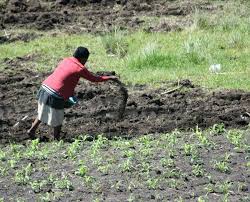Organic farming aims to produce high-quality products with superior nutritional value and no chemicals, promoting good health.
It focuses on creating a sustainable system that conserves energy, soil, and water, while maintaining the overall environment.
The key feature of organic agriculture is the absence of pesticides, herbicides, growth hormones, and antibiotics in the production process.
Organic farming relies on a combination of organic production methods working together for maximum benefit.
For example, using green manures alongside careful cultivation provides better weed control than either method alone.
Organic farming offers long-term benefits to people and the environment. Its goals include:
1. Increasing long-term soil fertility.
2. Controlling pests and diseases without harming the environment.
3. Ensuring clean and safe water.
4. Using available resources to reduce the cost of farm inputs.
5. Producing nutritious food, animal feed, and high-quality crops for sale at good prices.
Read Also: Chiggers: Description, Damages Caused, Control and Preventive Measures
Crop Nutrition Management in Organic Farming

To produce healthy crops, organic farmers must manage the soil effectively by considering soil life, nutrients, and structure.
Artificial fertilizers supply only short-term nutrients, promoting rapid but weak growth that is less resistant to drought, pests, and diseases.
These fertilizers do not nourish soil life or add organic matter, failing to improve soil structure, water retention, or drainage.
Soil is a living system containing millions of organisms essential for recycling nutrients. Feeding soil with manure or compost supports soil life, which transforms these materials into nutrients for plant growth while adding organic matter.
Green manures also contribute nutrients and organic matter. These are nitrogen-rich plants grown in rotation and incorporated into the soil when young.
However, excessive or poorly timed use of animal manure or nutrient-rich organic matter can be as harmful as artificial fertilizers.
Proper soil cultivation at the right time and manner is necessary to create optimal conditions for soil life and plant roots.
Selection of Crops and Importance of Crop Rotation
1. Choice of Crop for Local Conditions
Each crop and variety has specific requirements influenced by:
1. Soil type
2. Rainfall
3. Altitude
4. Temperature
5. Nutrient needs
6. Water requirements
Growing crops unsuited to local climate often results in low yields and increased pest and disease susceptibility, leading to reliance on agrochemicals. Successful organic farmers select crops and varieties adapted to their local geography and climate, often choosing native varieties.
2. Crop Rotation to Maintain Soil Fertility
Repeatedly growing the same crop on the same land reduces soil fertility and promotes pest, disease, and weed buildup. Rotating crops by moving them to different land each year, with a minimum 3-4 year cycle for vegetables, is recommended.
Crop rotation balances periods of nutrient depletion with periods of soil fertility restoration. It supports natural predators by providing diverse habitats and food sources.
A typical four-year rotation may include maize and beans, a root crop, cereals, and either grass/bush fallow or a legume crop grown as green manure.
3. Composting as a Soil Fertility Enhancer
Compost consists of decomposed organic matter such as leaves, fruit skins, and animal manure, broken down by bacteria and other organisms. It is inexpensive, easy to produce, and effectively improves soil and crop quality.
Compost benefits soil by:
1. Improving soil structure, increasing air flow, drainage, and reducing erosion.
2. Enhancing fertility by adding nutrients and making soil nutrients more available.
3. Increasing water retention, preventing drought stress.
4. Reducing pests and diseases in soil and crops.
Unlike chemical fertilizers, compost builds soil life and structure, resulting in lasting benefits. Various composting methods exist depending on materials and climate, including the Indore method, Bangalore method, heating/block method, Chinese high-temperature stack, pit, trench, basket, and boma composting.
4. Mulching for Soil Protection and Nutrient Management
Mulching involves covering the soil surface with loose materials such as compost, manure, straw, dry grass, leaves, or crop residues. Green vegetation is usually avoided due to slow decomposition and potential pest attraction.
Mulches improve soil and plant growth by:
1. Reducing water loss through evaporation.
2. Suppressing weed growth by blocking light.
3. Preventing soil erosion.
4. Increasing microorganisms in topsoil.
5. Adding nutrients and improving soil structure.
6. Adding organic matter to the soil.
Alternative mulching materials include black plastic sheeting and cardboard, which do not contribute nutrients or improve soil structure.
Proper mulching practices include applying mulch to warm, moist soil, avoiding excessive thickness to allow air flow, and adjusting thickness based on purpose (less than 10 cm for seed germination, 10 cm or more to control persistent weeds).
Read Also: Scrapie in Sheep and Goats: Description, Damages Caused, Control and Preventive Measures
Green Manuring to Enhance Soil Fertility

Green manures, or cover crops, are plants grown to improve soil structure, organic matter, and nutrient content. They serve as an affordable alternative or complement to artificial and animal fertilizers.
Green manures differ from regular legume crops by being dug into the soil while still young, before flowering, to add green leafy material rich in nutrients and provide soil cover.
Advantages of Green Manures include:
1. Increasing and recycling nutrients and organic matter.
2. Improving soil fertility and structure.
3. Enhancing water retention.
4. Controlling soil erosion.
5. Preventing weed growth.
6. Reducing nutrient loss during fallow periods.
This article explains that crop nutrition depends on feeding soil life and adding organic matter to improve soil structure, water retention, and drainage.
Soil is a living system containing numerous organisms essential for nutrient recycling. Feeding soil with manure or compost supports these organisms, converting organic matter into nutrients for plant growth.
Factors such as climate and soil influence crop growth and yield, making the choice of suitable crops and varieties essential for success. Repeatedly growing the same crop on the same land depletes fertility and increases pest problems, so crop rotation is necessary to maintain soil health and support natural predators.
Compost is defined as decomposed organic matter that improves soil quality affordably and effectively. Mulching involves covering soil with loose organic materials to conserve moisture, reduce weeds, and enhance soil health.
Green manures or cover crops improve soil nutrients, structure, and water retention and provide a sustainable alternative to artificial fertilizers.
Do you have any questions, suggestions, or contributions? If so, please feel free to use the comment box below to share your thoughts. We also encourage you to kindly share this information with others who might benefit from it. Since we can’t reach everyone at once, we truly appreciate your help in spreading the word. Thank you so much for your support and for sharing!
Frequently Asked Questions
We will update this section soon.

